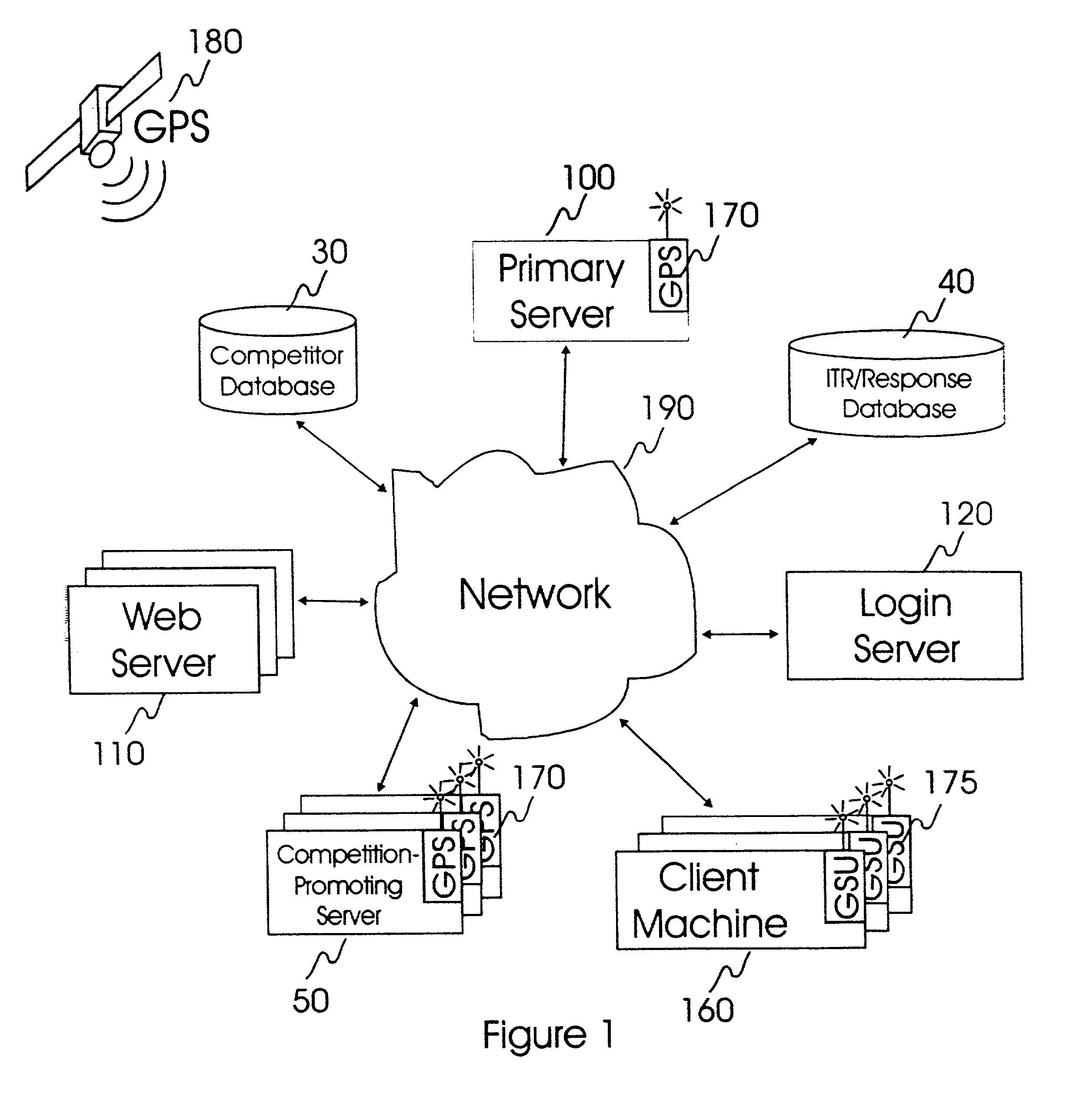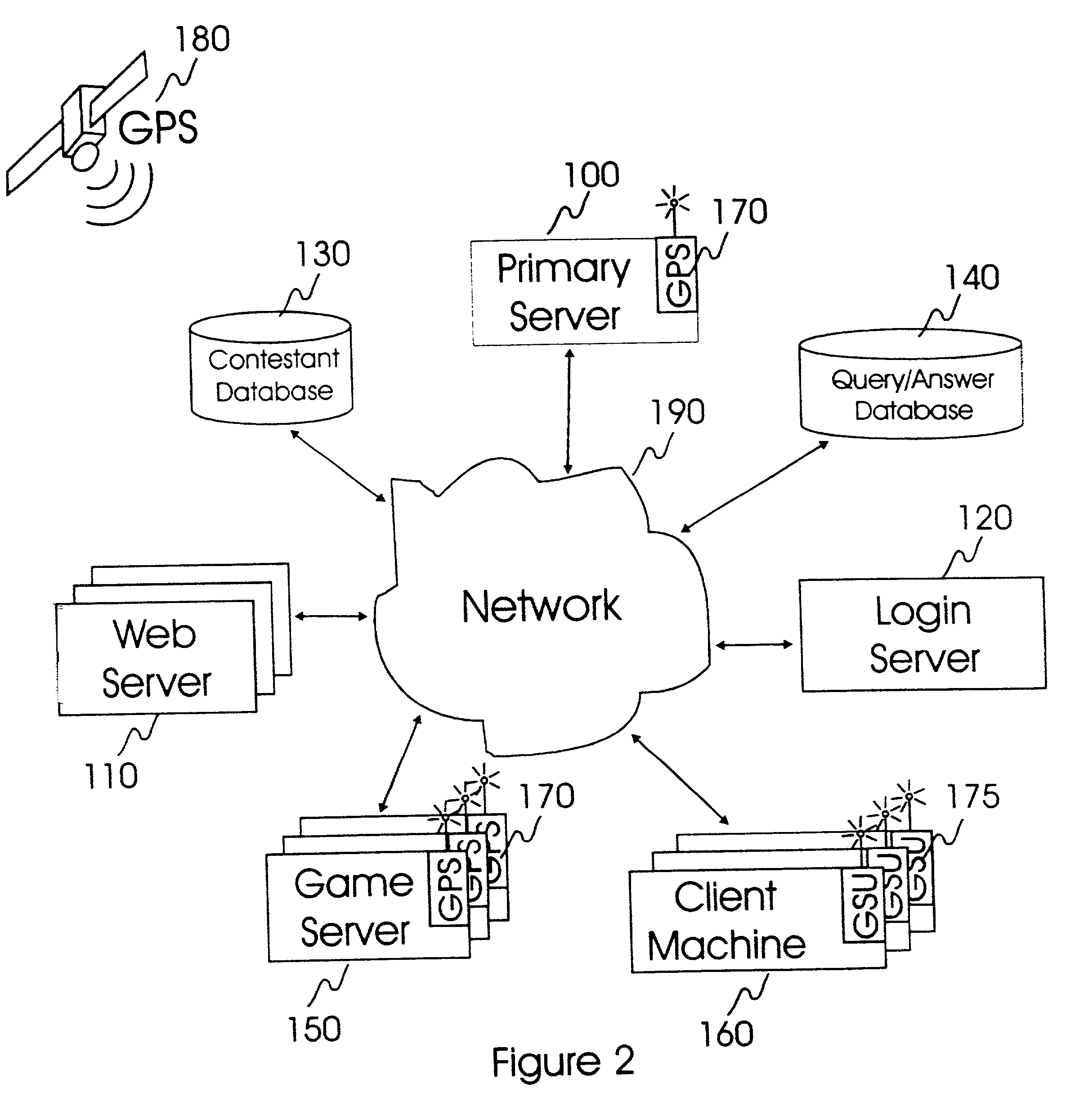In each of the above Internet-supported applications or processes, there currently exists an inherent unfairness among the competitors due to at least s-x important factors, namely: (1) the variable latency of (or
delay in) data
packet transmission over
the Internet, dependent on the type of connection each client subsystem has to the Internet infrastructure; (2) the variable latency of data
packet transmission over the Internet, dependent on the volume of congestion encountered by the data packets transmitted from a particular
client machine: (3) the
vulnerability of these applications to security breaches, tampering, and other forms of manipulation by computer and network hackers; (4) the latency of information
display device used in client subsystems connected to the Internet; (5) the latency of information
input device used in client subsystems connected to the Internet; and (6) the latency of the
central processing unit (CPU) used in the client
machine.
However, while this
system equalizes the communication latency on average, it is wholly incapable of compensating for the random components of network latency (i.e. variable network latency) of the Internet.
Consequently, even when practicing the methods disclosed in U.S. Pat. No. 5,820,463, the variable network latency of the Internet nevertheless introduces inherent
sources of error into time-constrained competitions, thereby putting certain competitors at an unfair
disadvantage, i.e. by virtue of their client computer connection to the Internet in relation to the information
server supporting the time-constrained competition.
Regarding the third unfairness factor, it is important to point out that each of the above-described time-constrained forms of Internet-supported competition are highly vulnerable to security breaches, tampering, and other forms of intentional network disruption by computer and network hackers.
Although the use of a local
clock insures fairness, it also raises a potential security problem with the system.
Theoretically, an unscrupulous competitor could intercept and modify communications between the client and
server, thereby falsifying the timestamps and gaining an unfair
advantage over other competitors.
Alternatively, an unscrupulous competitor could modify the local
clock, either through
software or hardware means, or interfere with the
clock synchronization procedure, again gaining an unfair
advantage over other competitors.
The ordinary
encryption / decryption techniques suggested in U.S. Pat. No. 5,820,463 are simply inadequate to prevent
cheating or violation of underlying rules of fairness associated with such time-constrained forms of Internet-supported or Internet-enabled competition.
Unless the vertical redraw time is synchronized with the desired competition "start-time" in time-constrained competition at hand, a
random error in the
start time is created due to the uncertainty of the actual time the query, bid, price or other
information element will be displayed on the display screen of a particular
client system used to participate in the time-constrained competition at hand.
This "information display latency" error can be as much as ten milliseconds or more depending on the vertical
sync rate, and is in addition to any other errors in the start-time caused by network latency,
computer processing time, and other factors.
This prior art method has a drawback in that it may be undesirable to modify the
refresh rate on a competitor's client
machine, since that is in part a personal preference, and typically under the control of the user.
All the client machine video-driver cards may not be physically capable of operating at the same refresh rates, particularly if they are not operating at the same resolution.
Also, the monitors themselves may not be capable of operating at a particular
refresh rate, and it may be necessary to operate at an undesirable "lowest
common denominator" frequency, or not at all.
This problem is compounded as more users and client machines are involved.
Another problem with this prior art display synchronization method is that
interlaced video modes are not possible on all video driver cards.
In addition, switching into interlaced
modes may temporarily disrupt the display as the monitor adjusts to
handle the new input.
Many display monitors will produce an annoying clicking
noise as the video mode is changed.
In short, depending on the type of
input device used, a competitor participating in an Internet-supported time-constrained competition can be put at a serious
disadvantage in comparison with those using high-speed information input devices and high-speed processors.
When competing against androidal competition (e.g. thinking machines), as currently used in electronic-based securities and commodity trading, and electronic-based auctions. human competitors are placed at a great
disadvantage in rapidly changing markets and fast-paced auctions.
Regarding the sixth unfairness factor, it must be pointed out that a further source of latency exists within each client machine due to the fact that the central processor unit (CPU) employed therein: services interrupts posted by competing
peripheral devices connected to the
client system bus; executes program instructions at a rate set by its clock speed; and has limited memory resources available at any instant in time.
These factors operate to further add a degree of
delay in when the data packets associated with the competitor's response is transmitted to the information server supporting the time-constrained competition.
Consequently, the six "unfairness" factors discussed above compromises the integrity any form of time-constrained competition supported on or otherwise enabled over the Internet.
 Login to View More
Login to View More  Login to View More
Login to View More 


